Balkinization
an unanticipated consequence of
Jack M. Balkin
Balkinization Symposiums: A Continuing List
E-mail:
Jack Balkin:
jackbalkin at yahoo.com
Bruce Ackerman
bruce.ackerman at yale.edu
Ian Ayres
ian.ayres at yale.edu
Corey Brettschneider
corey_brettschneider at brown.edu
Mary Dudziak
mary.l.dudziak at emory.edu
Joey Fishkin
joey.fishkin at gmail.com
Heather Gerken heather.gerken at yale.edu
Abbe Gluck abbe.gluck at yale.edu
Mark Graber
mgraber at law.umaryland.edu
Stephen Griffin
sgriffin at tulane.edu
Jonathan Hafetz
jonathan.hafetz at shu.edu
Jeremy Kessler
jkessler at law.columbia.edu
Andrew Koppelman
akoppelman at law.northwestern.edu
Marty Lederman
msl46 at law.georgetown.edu
Sanford Levinson
slevinson at law.utexas.edu
David Luban
david.luban at gmail.com
Gerard Magliocca
gmaglioc at iupui.edu
Jason Mazzone
mazzonej at illinois.edu
Linda McClain
lmcclain at bu.edu
John Mikhail
mikhail at law.georgetown.edu
Frank Pasquale
pasquale.frank at gmail.com
Nate Persily
npersily at gmail.com
Michael Stokes Paulsen
michaelstokespaulsen at gmail.com
Deborah Pearlstein
dpearlst at yu.edu
Rick Pildes
rick.pildes at nyu.edu
David Pozen
dpozen at law.columbia.edu
Richard Primus
raprimus at umich.edu
K. Sabeel Rahmansabeel.rahman at brooklaw.edu
Alice Ristroph
alice.ristroph at shu.edu
Neil Siegel
siegel at law.duke.edu
David Super
david.super at law.georgetown.edu
Brian Tamanaha
btamanaha at wulaw.wustl.edu
Nelson Tebbe
nelson.tebbe at brooklaw.edu
Mark Tushnet
mtushnet at law.harvard.edu
Adam Winkler
winkler at ucla.edu
Compendium of posts on Hobby Lobby and related cases
The Anti-Torture Memos: Balkinization Posts on Torture, Interrogation, Detention, War Powers, and OLC
The Anti-Torture Memos (arranged by topic)
Recent Posts
Five Lessons from Kersch’s Conservatives and the Constitution for the Present Moment
Just A Few Blogs
ACS Blog
Alas, a Blog
Althouse
Arts and Letters Daily
Atrios (Eschaton)
Bill of Health
Buzzflash.com
Buzz Machine
Cato at Liberty
Juan Cole (Informed Comment)
Concurring Opinions
The Constitution in 2020
Corrente
Crooked Timber
Daily Howler
Daily Kos
Dana Boyd
Brad DeLong
Digby (Hullabaloo)
Discriminations
Daniel Drezner
Kevin Drum (Mother Jones)
Electrolite
En Banc
Eunomia (Daniel Larison)
Fafblog
Michael Froomkin (Discourse.net)
GovLab (Beth Noveck)
Rick Hasen (Election Law)
History News Network
How Appealing
Ignatz (Sam Heldman)
The Importance of (Ernie Miller)
Infolaw
Instapundit
International Economic Law and Policy Blog
IntLawGrrls
Jacob Levy
Jesus' General
Jurisdynamics
The Kitchen Cabinet
Mark Kleiman
Law Blog Central
Larry Lessig
Lawyers, Guns and Money
Liberal Oasis
Brian Leiter's Law School Reports
The Leiter Reports
Marginal Revolution
Megan McArdle
Memeorandum
Metafilter
Mirror of Justice
The New Republic
Newseum
No More Mister Nice Blog
Brendan Nyhan
Opinio Juris
Orcinus
The Originalism Blog
Pandagon
Passport (Foreign Policy)
Overcoming Bias
Political Animal (Washington Monthly)
Political Theory Daily Review
Political Wire (Taegan Goddard)
The Poor Man
Virginia Postrel
Prawfsblawg
Public Reason
Jonathan Rauch
Raw Story
Redstate
ReligiousLeftLaw.com
Reporters Committee For Freedom of the Press
Reproductive Rights Blog
Rothman's Roadmap to the Right of Publicity
SCOTUS Blog
Seeing the Forest
Clay Shirky
The Shifted Librarian
The Situationist
Larry Solum (Legal Theory)
Andrew Sullivan
Talking Points Memo
Talk Left
Tapped
Tbogg
TechPresident
The Paper Chase (Jurist)
Tom Paine
Tom Tomorrow (This Modern World)
Eve Tushnet
Uggabugga
University of Chicago Law School Faculty Blog
Unqualified Offerings
The Volokh Conspiracy
War and Piece (Laura Rozen)
Wampum
Oliver Willis
Wonkette
Written Description
Matthew Yglesias
Yin
Your Choice of Feeds
1. XML
powered by
2. Atom Feed
3. RSS 2.0
Five Lessons from Kersch’s Conservatives and the Constitution for the Present Moment
Guest Blogger
For the Balkinization symposium in honor of Ken Kersch James E. Fleming and Linda C. McClain We
had the good fortune and great pleasure to be good friends of and in
intellectual conversation with Ken Kersch. We appreciate the opportunity,
through this Balkinization symposium on his work, to try to honor his legacy by
offering some thoughts on his erudite and sobering work concerning conservative
political and constitutional thought in the U.S. A
recent “Best Sellers” list in the New
York Times Book Review describes Timothy Snyder’s On Tyranny as follows: “Twenty lessons from the 20th
century about the course of tyranny.” Kersch’s Conservatives and
the Constitution:
Imagining Constitutional Restoration in the Heyday of American Liberalism (2019) provides at least twenty lessons from the second
half of the 20th century about the development of conservative
constitutional thought and activism. These lessons are relevant for
understanding the present political moment, filled with concerns that the U.S.,
several months into the second Trump Administration, is lurching toward
tyranny, authoritarianism, and totalitarianism. Kersch’s book highlights that a
recurring refrain by conservative thought-makers and politicians during their “wilderness
years,” or “postwar liberalism’s heyday between 1954 and 1980,” was that
conservatism’s enemies—including not only “godless communism,” moral
relativism, and secularism, but also liberalism and liberal “living”
constitutionalism—were leading the U.S. toward totalitarianism and
authoritarianism. As his subtitle indicates, conservatives envisioned
constitutional restoration (and redemption), to be ushered in when Republicans
returned to political power and control of the judiciary. In this post, we
sketch five lessons from Kersch’s book. 1.
Narratives matter. From its opening
pages, Conservatives and the Constitution
argues that understanding the modern conservative movement and what
conservatives mean by “constitutional restoration” requires examining how the
various strands of conservativism—”Fundamentalist and Evangelical Christians,
right-wing Roman Catholics, fervent anticommunists, and anti-statist
libertarians”—all “told passion-laden and memory-drenched stories” about the
U.S.’s “history and trajectory and their place within it” (xiii). This provided
“motivation for, and prologue to, imagine the country’s future, should they
reclaim power to direct it” (Id.).
Kersch meticulously explicates those different narratives within the modern
conservative movement, charting how they shared, as a “motivating and unifying
rallying cry,” the “call for constitutional restoration and redemption” (367). Constitutional
scholars in recent decades—including Jack Balkin, Peggy Cooper Davis, Reva Siegel,
and Serena Mayeri—have identified the critical role of constitutional memory,
including the stories people tell about the Founding, the Framers, the
Constitution, and the meaning of famous constitutional law cases. Kersch’s book
is a rich resource in capturing the strands of conservative narrative and
constitutional memory. In Trump 2.0, the need to focus on narrative seems even
more pressing. As Kersch observes: There
are, after all, different ways of telling the story of how the Constitution
came into being and why; what it was, did, and does; how it was used,
respected, honored, lost, abandoned, or betrayed; how it succeeded or failed,
proved durable, workable, distorting, hopeless, or malign; who is helped or
hurt, served, advanced, privileged, marginalized, or oppressed; when any of
these happened, or did not; who deserves credit, honor, or blame; and what
these imply or teach about the contemporary and future problems and
possibilities of individuals, the nation, and humanity (368). Liberals
and progressives, he adds, tell their own stories about these matters. After
the 2024 election, some commentators have argued that liberals and progressives
have to construct more effective constitutional narratives. Further, in the
face of evident backlash against gender equality (as in the bellicose (“bro”)
masculinity of the Trump cabinet), Tarana Burke (founder of MeToo) argues that
progressives are losing the “narrative game.” 2. Conservatives view the (liberal) American
regulatory state as akin to communism. Conservatives and the Constitution
explores a striking phenomenon in U.S. opposition to communism. On the one
hand, “a staunch anticommunism was a defining feature of postwar American
conservatism,” as well as “the consistent position” of leading liberal
politicians and liberal organizations (201). On the other hand, the Vietnam War
challenged this “consensus” position, as some liberal opponents of the Vietnam
war blamed it on “an ill-judged anticommunist zeal” (Id.). Meanwhile, for many on the right, “communism” became the
preeminent enemy: “the existential threat to the very survival of John
Winthrop’s ‘City on a Hill,’ of God’s chosen nation” (202). And “communism”
also became a “heuristic” for “understanding, tarring, and damning the liberal
thought-leaders and policy intellectuals now building out the modern American
state” (203). These Cold War conservatives viewed those liberals as “domestic
analogues to Soviet Communism’s vanguard Leninist cadres” (Id.). Given
that many of the Right’s outspoken anticommunist conservatives began as “communist
or socialist intellectuals steeped in radical political thought,” Kersch
theorizes that many “transferred their radical faith, zeal, militancy, and
Manicheanism from communism to anticommunism” (207). Because communism, some
argued, was an “aggressive faith that rejects God,” it was necessary to shore
up the understanding of the U.S. as a Christian nation, through such “ceremonial
deism” as adding “In God We Trust” to U.S. currency and the language, “One
Nation Under God,” to the Pledge of Allegiance (which itself was only adopted
as the official pledge in 1945) (212-213). The effort, however, to add a
Christian Amendment to the Constitution—to correct the Framers’ “founding error”
of not mentioning “God” in that document—did not succeed (213). There
is notable continuity between the anticommunism of that era and anti-liberalism
today. Then, as now, conservatives find an “existential threat” lurking in “the
country’s modern New Deal administrative, regulatory, and social welfare
programs” (244)—warranting the chainsaw-brandishing Elon Musk’s’ zealous
dismantling. Further, in the 2024 presidential election, President Trump
resorted to the “Red-baiting playbook,” calling Democratic nominee Vice
President Kamala Harris “Comrade Kamala”
and falsely claiming that she had “always been a communist.” Trump and
prominent supporters (including Musk) repeatedly branded Harris and Governor
Tim Walz and their policies as “communist,” Marxist, or Leninist. To any
liberals or progressives who think Trump was exaggerating for rhetorical
purposes and that many Republicans accepted this, Kersch’s book provides a
sobering correction—it enables us to see the straight line connecting 1950s
anticommunism and contemporary anti-liberalism and Christian nationalism. In
Project 2025 (Mandate for Leadership: The
Conservative Promise), the Foreword by Kevin D. Roberts refers to President
Reagan as defeating the “beasts” of “the Soviet Union, the socialism of 1970s
liberals, and the predatory deviancy of cultural elites” (3). It also links
progressivism and “wokeism” to Communism. Thus, in Promise #4: Secure Our
God-Given Individual Right to Enjoy “The Blessings of Liberty,” Roberts argues
that “the American people” have rejected “slavery, second-class citizenship for
women, mercantilism, socialism, Wilsonian globalism, Fascism, Communism, and
(today) wokeism.” Yet, “to the Left, these assertions of patriotic
self-assurance are just so many signs of our moral depravity and intellectual
inferiority—proof that, in fact, we need a ruling elite to making decisions for
us” (14). Roberts also treats “Communism” as a synonym for socialism, Marxism,
progressivism, and Fascism. 3.
A “co-belligerent” Christian
constitutionalism—and nationalism—united Evangelical Christians and the
Catholic Right and put them on the “right” side of civil rights. Conservatives
and the Constitution intricately charts the emergence of what Kersch calls
a “Christian co-belligerence,” uniting Evangelicals and conservative Catholics,
among other “religiously diverse strands of the Religious Right,” under “the
Constitution’s banner” (350). He argues that conservative Catholics played a
growing role in this effort. While this might seem “surprising,” given the “anti-Catholic
Protestantism” and “Enlightenment liberalism” of the Founders, Kersch explains
that this was due to conservative Catholics re-narrating the nation’s history
as “anchored in the commitments and principles of the Catholic faith,” so that “only a Roman Catholic framework could
fully illuminate the American Founders’ achievement” (357). (Since Kersch
wrote, we have seen Adrian Vermeule’s well-known argument for a “common good
constitutionalism” rooted in the classical tradition. As another example, in Classical and
Christian Origins of American Politics: Political Theology, Natural Law, and
the Christian Founding, Kody W.
Cooper and Justin Buckley Dyer argue that “ideas central to the American
founding . . . presupposed classical natural law and theology” and that there
is a “deep, deep continuity” from Aristotle and Aquinas to the founding (7).)
At an institutional level, Kersch points out how efforts of prominent figures
such as Professor Robert P. George of Princeton University, an “intellectual
impresario of the nation’s far Right,” have helped to forge the “co-belligerence
that has united the once theologically divided factions of the modern Religious
Right and immensely strengthened their political and legal influence” (358).
Redeeming the “American constitutional project” is a central aim (Id.). Such efforts also require civic
narratives. Kersch
argues that culture wars have played a large role in this narrative. Decades
ago, Evangelical and Fundamentalist Christians who helped sweep President
Reagan to power built bridges with conservative Catholics through an “overarching
story of the crisis of Christian civilization” as being on “the verge of
succumbing to an existential threat launched by the secularists, humanists,
positivists, historicists, and nihilists who supported abortion, socialism, and
gay rights” (367). He observes that this political and constitutional coalition
has held together for nearly half a century (Id.). In
his conclusion, Kersch notes the striking degree to which this co-belligerent
Christian Right has “become second to none in repeatedly and aggressively
denouncing chattel slavery,” a phenomenon he calls a “strident,” “vicarious abolitionism” (369). As he
explains, the Christian Right engages in re-narrating “the history of the
nineteenth-century legal and constitutional order” in ways supportive of their “co-belligerent
compatriots” (373). For example, as Evangelicals praise Catholic “systematic
theology” as “simply following the path of moral logic to which any reasonable
person must assent,” Roman Catholic constitutionalists praise “the role that
Godly Evangelical Christians” played in ending chattel slavery (Id.). However, as Kersch points out, “the
distinction between the northern Evangelical abolitionists who opposed chattel
slavery and the mainly (white) southern
Evangelical Christians who fervently enlisted Scripture in justifying and
defending it” is one on which “the contemporary Christian Right, rooted in the
South, chooses not to dwell” (Id.). Kersch
observes that this “abolitionism” also “seems to strangely co-exist with a
palpable indifference to the concerns of contemporary African Americans on
issues such as the carceral state, police brutality, voting rights, and the
racism of President Trump (among others)” (Id.).
The contemporary Right then uses this “fire-breathing abolitionism” as a “bludgeon
to pummel liberals—or, rather, progressives—who, presumably, are thoroughgoing
positivists, utilitarians, historicists, secularists, cultural relativists, and
nihilists” (370). They seem to find chattel slavery’s “contemporary legacy in
the push for progressivism and abortion rights and gay rights” (371). To this,
we would add, writing in 2025, and given the rhetoric of the 2024 election, the
rights of transgender persons. The historical analogies drawn by these
vicarious abolitionists cast “conservatives” in “the role of Frederick Douglass
and Abraham Lincoln, while the liberals and progressives are cast as Roger
Brooke Taney, the infamous author of Dred
Scott, and the slavery-accommodating Illinois Senator Stephen A. Douglas .
. . if not worse” (370). The
trend that Kersch identified in 2019 is quite pertinent in 2025: By executive
order, President Trump re-established the 1776 Commission to promote “patriotic
education.” In its 1776 Report, the
Commission drew precisely the parallels that Kersch mentions, treating all
civil rights developments since the enactment of the Civil Rights Act of 1964 as
moves toward an illegitimate “color conscious” rather than “colorblind”
society. Both Project 2025 and the slew of executive orders condemning “DEI”
and “discriminatory equity ideology” and “gender ideology” implausibly and
dangerously invert understandings of “civil rights.” 4. The right settled on originalism only after
a broader constitutional theory debate concerning substantive visions. Conservative
constitutional visions were the primary driving forces toward unity on the
basis of originalism. In 1954, it was not preordained that the many strands of
conservative constitutional thought would settle on originalism as its fighting
faith, or that originalism would unite the right. To be sure, we see a
proto-originalism in documents resisting Brown
v. Board of Education, like the Southern Manifesto and Nullification
Resolutions. We see the very same proto-originalism in the briefs filed in the
1954 re-argument in Brown in support
of reaffirming Plessy v. Ferguson. What
is more, 1950s proto-originalist liberals including Justice Hugo Black and
Professor W.W. Crosskey had demonstrated the usefulness of originalism as a
wrecking ball for tearing down doctrines standing in the way of instantiation
of a substantive vision of the Constitution (83-85). But, as Kersch
clear-headedly and painstakingly recounts, the many strands of conservative
constitutional thought largely existed outside the courts as substantive
constitutional visions, not lawyerly conceptions of how to interpret the
Constitution. It
is commonplace for critics of originalism to argue that it is a cover or
disguise for the imposition of conservative views. Critics typically deliver
these criticisms as reductive, disparaging put-downs of sanctimonious
conservative pretensions to neutrality or objectivity in constitutional
interpretation. Kersch’s book, without being reductive or disparaging, richly
demonstrates that the primary driving forces behind the unification of
conservativism on the basis of originalism are conservative substantive
visions. 5.
As conservatives gained control of the
judiciary, a new “originalism” licensed aggressive judicial review by
conservative judges to promote conservative substantive visions. Like Keith
Whittington, Kersch distinguishes two phases in the development of originalism:
(1) the initial proceduralist and institutionalist call for “judicial restraint”
in criticisms that delegitimize the decisions of the Warren Court and the
moderately conservative Burger Court, at the time when early originalists were
still voices crying in the wilderness (Bork (1971), Berger (1977), and Scalia
(1989)), followed by (2) the emergence of the new originalism as a program for
affirmatively implementing conservative substantive visions of the Constitution
once conservatives become a governing majority on the Supreme Court. Although
the justices on the Roberts Court would not admit it, they clearly have moved
from the first phase to the second phase, especially since Dobbs. The second Trump Administration clearly understands this,
and rightly does not expect much pushback from the Roberts Court as it
aggressively carries out its constitutional revolution. We
have always viewed the latter stage instead as conservative moral
readings—substantive visions of the Constitution’s basic structures and
commitments—rather than, say, a faithful account of the founding or original
public meaning of the Reconstruction amendments as such. Thus, it seems to us
that Adrian Vermeule’s characterization is very much on the mark: that in the
first phase, originalism served its largely negative purpose, but now that we
are in the second phase, conservatives should move “beyond originalism”
and openly implement a conservative moral reading of the Constitution. Yet,
it probably is the case that, for reasons of temperament and rhetoric,
conservatives will continue to wear originalist garb or perform acts of what
Balkin calls “historical ventriloquism,” putting their conservative visions in
the mouths of the framing and ratifying generations. Temperamentally and
rhetorically, discourse of a restoration or redemption of a founding—or a
return to fidelity to first principles—is more congenial to them than is
discourse of implementing a conservative substantive vision or constructing a
conservative moral reading. What
is more, by their conservative lights, even after the pervasive and unrelenting
disruption of constitutional doctrine wrought by the Trump Court since 2020,
constitutional law is still littered through and through with liberal
precedents and so they still need to use the demolition crew of originalists to
tear it all down. Finally, as Kersch would have been the first to emphasize,
conservative constitutional law professors may be more comfortable with the
idiom of “neutrality” or “processes” or “matter of interpretation” than with
forthrightly advocating for imposing a substantive vision. This applies even
more so to conservatives on the Supreme Court. *
* * In
concluding, we want to repeat what we said at the beginning: narratives matter. As we observed, most
law professors, if they are familiar with the ideas of constitutional
redemption, story, memory, and narrative, probably think of the work of our
blog host, Jack Balkin, his Yale Law School colleague Reva Siegel, Serena
Mayeri, and, before them, Peggy Cooper Davis. Kersch’s Conservatives and the Constitution deserves a place in the standard
string citation to scholars developing and applying these ideas. Now, these
ideas are not inherently conservative, but Kersch argues and demonstrates in
rich detail that conservatives have been far more adept than liberals and
progressives in communicating and mobilizing through using these ideas. Furthermore,
through the ideas of redemption, story, memory, and narrative, Kersch weaves
together the materials forming a conservative “incompletely theorized agreement”
or “overlapping consensus.” Many have pondered what unites the evidently
discordant strains of conservative argumentation today. Most pundits and
scholars have constructed largely negative accounts, e.g., what united the
Republican Party in 2016 was more hatred of Hillary Clinton, or agreement about
the necessity of repudiating everything Barack Obama had accomplished, than
agreement that Donald Trump would make a good president. Kersch provides a more
positive account: what unites the right around Trump is an overlapping
consensus among quite different conservative views about the urgency of
redeeming the promise of the “city on a hill,” or making America great again. Relatedly,
countless pundits and scholars have come around to the view that Trump is not
an aberration but instead the culmination of certain strands or forces in the
evolution of the Republican Party. Kersch’s book contributes to this
understanding. Because his book is about conservative ideas, it contributes
less to political science literature on why Trump won the presidency twice than
to understanding how numerous strands of conservative thought since 1954 have
borne fruit in Project 2025. Kersch puts the matter in terms of a recurring
refrain: these ideas have been “hiding in plain sight.” Finally,
Kersch’s book enables us to see that many conservative ideas that initially
seemed shocking—like Michael Anton’s argument that the 2016 election’s choice
between Trump and Clinton resembled the choice of the passengers on Flight
93—make perfect sense of the state of the conservative mind in the U.S. today
(374-78). As does the evidently counter-intuitive appeal of Trump the
immoralist to conservative Christian moralists. It appears that the
conservative never-Trumpers whom we have long admired did not get the memo.
Barry Goldwater put it best when he said in the most famous line of his 1964
nomination acceptance speech (penned by Straussian Harry Jaffa): “Extremism in
the defense of liberty is no vice” (53 n.76). To many, that sounded like
unhinged paranoia during Goldwater’s presidential campaign in 1964. However,
today, to many conservatives, it evidently sounds like the common sense truth
of the matter. Hence, to many of them, tyranny and authoritarianism may seem
necessary to them to restore constitutional virtue and to restore the blessings
of honorable liberty. Reading Kersch’s book enables us to appreciate this.
James Fleming, jfleming@bu.edu, is the Hon. Paul
J. Liacos Professor of Law at Boston University School of Law. Linda McClain,
lmcclain@bu.edu, is the Robert Kent Professor of Law at BU Law.
Posted
9:30 AM
by Guest Blogger [link]
Books by Balkinization Bloggers

Gerard N. Magliocca, The Actual Art of Governing: Justice Robert H. Jackson's Concurring Opinion in the Steel Seizure Case (Oxford University Press, 2025)

Linda C. McClain and Aziza Ahmed, The Routledge Companion to Gender and COVID-19 (Routledge, 2024)

David Pozen, The Constitution of the War on Drugs (Oxford University Press, 2024)

Jack M. Balkin, Memory and Authority: The Uses of History in Constitutional Interpretation (Yale University Press, 2024)
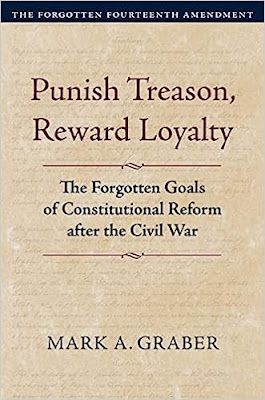
Mark A. Graber, Punish Treason, Reward Loyalty: The Forgotten Goals of Constitutional Reform after the Civil War (University of Kansas Press, 2023)
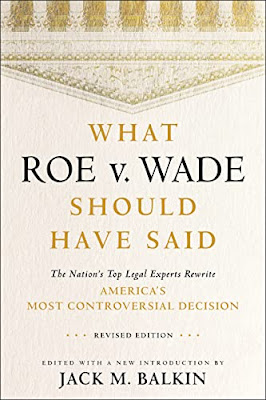
Jack M. Balkin, What Roe v. Wade Should Have Said: The Nation's Top Legal Experts Rewrite America's Most Controversial Decision - Revised Edition (NYU Press, 2023)

Andrew Koppelman, Burning Down the House: How Libertarian Philosophy Was Corrupted by Delusion and Greed (St. Martin’s Press, 2022)

Gerard N. Magliocca, Washington's Heir: The Life of Justice Bushrod Washington (Oxford University Press, 2022)
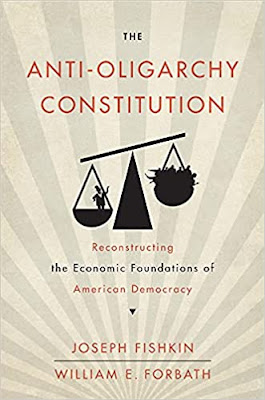
Joseph Fishkin and William E. Forbath, The Anti-Oligarchy Constitution: Reconstructing the Economic Foundations of American Democracy (Harvard University Press, 2022)

Mark Tushnet and Bojan Bugaric, Power to the People: Constitutionalism in the Age of Populism (Oxford University Press 2021).

Mark Philip Bradley and Mary L. Dudziak, eds., Making the Forever War: Marilyn B. Young on the Culture and Politics of American Militarism Culture and Politics in the Cold War and Beyond (University of Massachusetts Press, 2021).

Jack M. Balkin, What Obergefell v. Hodges Should Have Said: The Nation's Top Legal Experts Rewrite America's Same-Sex Marriage Decision (Yale University Press, 2020)

Frank Pasquale, New Laws of Robotics: Defending Human Expertise in the Age of AI (Belknap Press, 2020)

Jack M. Balkin, The Cycles of Constitutional Time (Oxford University Press, 2020)

Mark Tushnet, Taking Back the Constitution: Activist Judges and the Next Age of American Law (Yale University Press 2020).

Andrew Koppelman, Gay Rights vs. Religious Liberty?: The Unnecessary Conflict (Oxford University Press, 2020)

Ezekiel J Emanuel and Abbe R. Gluck, The Trillion Dollar Revolution: How the Affordable Care Act Transformed Politics, Law, and Health Care in America (PublicAffairs, 2020)

Linda C. McClain, Who's the Bigot?: Learning from Conflicts over Marriage and Civil Rights Law (Oxford University Press, 2020)
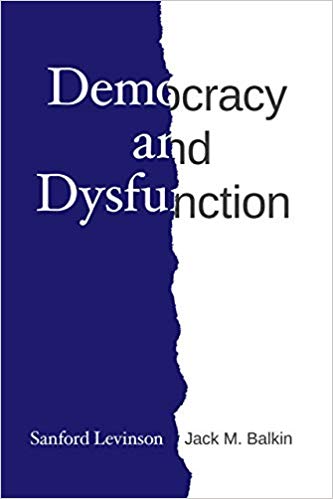
Sanford Levinson and Jack M. Balkin, Democracy and Dysfunction (University of Chicago Press, 2019)

Sanford Levinson, Written in Stone: Public Monuments in Changing Societies (Duke University Press 2018)

Mark A. Graber, Sanford Levinson, and Mark Tushnet, eds., Constitutional Democracy in Crisis? (Oxford University Press 2018)

Gerard Magliocca, The Heart of the Constitution: How the Bill of Rights became the Bill of Rights (Oxford University Press, 2018)

Cynthia Levinson and Sanford Levinson, Fault Lines in the Constitution: The Framers, Their Fights, and the Flaws that Affect Us Today (Peachtree Publishers, 2017)

Brian Z. Tamanaha, A Realistic Theory of Law (Cambridge University Press 2017)

Sanford Levinson, Nullification and Secession in Modern Constitutional Thought (University Press of Kansas 2016)

Sanford Levinson, An Argument Open to All: Reading The Federalist in the 21st Century (Yale University Press 2015)

Stephen M. Griffin, Broken Trust: Dysfunctional Government and Constitutional Reform (University Press of Kansas, 2015)

Frank Pasquale, The Black Box Society: The Secret Algorithms That Control Money and Information (Harvard University Press, 2015)

Bruce Ackerman, We the People, Volume 3: The Civil Rights Revolution (Harvard University Press, 2014)
Balkinization Symposium on We the People, Volume 3: The Civil Rights Revolution

Joseph Fishkin, Bottlenecks: A New Theory of Equal Opportunity (Oxford University Press, 2014)

Mark A. Graber, A New Introduction to American Constitutionalism (Oxford University Press, 2013)

John Mikhail, Elements of Moral Cognition: Rawls' Linguistic Analogy and the Cognitive Science of Moral and Legal Judgment (Cambridge University Press, 2013)

Gerard N. Magliocca, American Founding Son: John Bingham and the Invention of the Fourteenth Amendment (New York University Press, 2013)

Stephen M. Griffin, Long Wars and the Constitution (Harvard University Press, 2013)

Andrew Koppelman, The Tough Luck Constitution and the Assault on Health Care Reform (Oxford University Press, 2013)

James E. Fleming and Linda C. McClain, Ordered Liberty: Rights, Responsibilities, and Virtues (Harvard University Press, 2013)
Balkinization Symposium on Ordered Liberty: Rights, Responsibilities, and Virtues

Andrew Koppelman, Defending American Religious Neutrality (Harvard University Press, 2013)

Brian Z. Tamanaha, Failing Law Schools (University of Chicago Press, 2012)

Sanford Levinson, Framed: America's 51 Constitutions and the Crisis of Governance (Oxford University Press, 2012)

Linda C. McClain and Joanna L. Grossman, Gender Equality: Dimensions of Women's Equal Citizenship (Cambridge University Press, 2012)

Mary Dudziak, War Time: An Idea, Its History, Its Consequences (Oxford University Press, 2012)

Jack M. Balkin, Living Originalism (Harvard University Press, 2011)

Jason Mazzone, Copyfraud and Other Abuses of Intellectual Property Law (Stanford University Press, 2011)

Richard W. Garnett and Andrew Koppelman, First Amendment Stories, (Foundation Press 2011)

Jack M. Balkin, Constitutional Redemption: Political Faith in an Unjust World (Harvard University Press, 2011)

Gerard Magliocca, The Tragedy of William Jennings Bryan: Constitutional Law and the Politics of Backlash (Yale University Press, 2011)

Bernard Harcourt, The Illusion of Free Markets: Punishment and the Myth of Natural Order (Harvard University Press, 2010)

Bruce Ackerman, The Decline and Fall of the American Republic (Harvard University Press, 2010)
Balkinization Symposium on The Decline and Fall of the American Republic

Ian Ayres. Carrots and Sticks: Unlock the Power of Incentives to Get Things Done (Bantam Books, 2010)

Mark Tushnet, Why the Constitution Matters (Yale University Press 2010)
Ian Ayres and Barry Nalebuff: Lifecycle Investing: A New, Safe, and Audacious Way to Improve the Performance of Your Retirement Portfolio (Basic Books, 2010)
.jpg)
Jack M. Balkin, The Laws of Change: I Ching and the Philosophy of Life (2d Edition, Sybil Creek Press 2009)

Brian Z. Tamanaha, Beyond the Formalist-Realist Divide: The Role of Politics in Judging (Princeton University Press 2009)
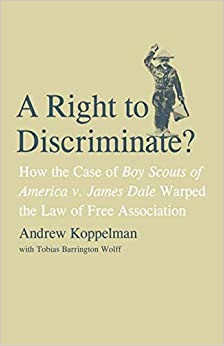
Andrew Koppelman and Tobias Barrington Wolff, A Right to Discriminate?: How the Case of Boy Scouts of America v. James Dale Warped the Law of Free Association (Yale University Press 2009)

Jack M. Balkin and Reva B. Siegel, The Constitution in 2020 (Oxford University Press 2009)
Heather K. Gerken, The Democracy Index: Why Our Election System Is Failing and How to Fix It (Princeton University Press 2009)

Mary Dudziak, Exporting American Dreams: Thurgood Marshall's African Journey (Oxford University Press 2008)

David Luban, Legal Ethics and Human Dignity (Cambridge Univ. Press 2007)

Ian Ayres, Super Crunchers: Why Thinking-By-Numbers is the New Way to be Smart (Bantam 2007)

Jack M. Balkin, James Grimmelmann, Eddan Katz, Nimrod Kozlovski, Shlomit Wagman and Tal Zarsky, eds., Cybercrime: Digital Cops in a Networked Environment (N.Y.U. Press 2007)

Jack M. Balkin and Beth Simone Noveck, The State of Play: Law, Games, and Virtual Worlds (N.Y.U. Press 2006)

Andrew Koppelman, Same Sex, Different States: When Same-Sex Marriages Cross State Lines (Yale University Press 2006)
Brian Tamanaha, Law as a Means to an End (Cambridge University Press 2006)
Sanford Levinson, Our Undemocratic Constitution (Oxford University Press 2006)
Mark Graber, Dred Scott and the Problem of Constitutional Evil (Cambridge University Press 2006)
Jack M. Balkin, ed., What Roe v. Wade Should Have Said (N.Y.U. Press 2005)
Sanford Levinson, ed., Torture: A Collection (Oxford University Press 2004)
Balkin.com homepage
Bibliography
Conlaw.net
Cultural Software
Writings
Opeds
The Information Society Project
BrownvBoard.com
Useful Links
Syllabi and Exams